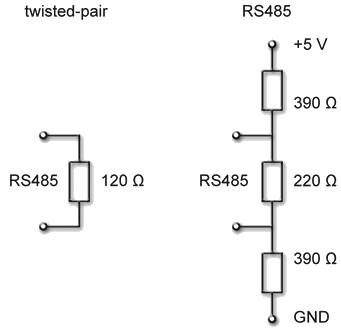
ExpertDAQ fieldbus modules communicate via serial interfaces. Serial data transfer is characterized by the fact that individual bits are sent one after another. Still, the transmitter processes the data in parallel, so it converts the data from parallel to serial, while the receiver performs the process in reverse. The main advantage of serial communication is the fact that only one signal line is required, while parallel transfer requires one line for each bit that is to be transferred in parallel.
With serial data transmission, either point-to-point connections or networks can be built. The important parameters are transfer direction, data throughput and the maximum transmission rate.
Regarding the transfer direction, there is simplex, half-duplex and full-duplex. Simplex means that data only flows in one direction. Half-duplex means that data can flow in both directions, but not at the same time. Using a full-duplex connection, communication can be done in both directions at the same time.
Using RS485, multiple devices can be connected in a network. Note, however, that star topologies are to be avoided due to line reflections (see below).
During data transfer, sender and receiver must synchronize. This is done by sending a bit that signals the start of the transmission, after which 8 bits are sent, followed by a parity bit to check for transmission errors. A stop bit then signals the end of the transmission.
RS232 is used for point-to-point connections. The RS232 signal is ground-referenced, so the lines are susceptible to external interference. Therefore, RS232 connections can only be used over distances of a few meters.
RS422 / RS485 connections can handle data rates of up to 100 kbit/s even at large distances of up to 1200m. RS422 uses a 4-wire full-duplex connection. RS485 typically uses a 2-wire half-duplex connection. With full-duplex connections, the receiving channels of one device are connected to the transmission channels of the other device. RS422 / RS485 is not as susceptible to interference from the outside as RS232, because the signal is not based on the voltage to ground, but on the voltage difference between the two signal lines. Outside interferences change the amplitude of both signal lines by the same amount, so the voltage difference is preserved.
RS485 enables bidirectional bus communication. Therefore, RS485 is suitable for use in field networks. RS485 enables half-duplex communication using a 2-wire connection. However, care must be taken that only one sender is active at any given time. Therefore, often a master-slave structure is built.
The maximum cable length for data rates of up to 9.6kbit/s is 1200m. At higher data rates, the maximum line length decreases. For data rates of 12 Mbit/s, the line length must not exceed 100m.
Correct line termination is important for all connections. With twisted pair cables, a 120 ohm resistor is sufficient. For RS485, three resistors are needed to ensure the correct resting potential (see picture).

